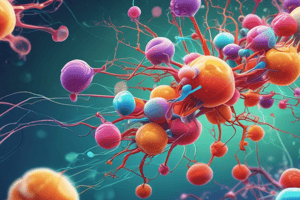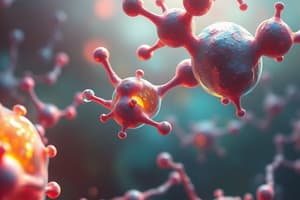Podcast
Questions and Answers
Which organism is considered ideal for studies involving egg fertilization and embryogenesis?
Which organism is considered ideal for studies involving egg fertilization and embryogenesis?
- House mouse (Mus musculus)
- Fruit fly (Drosophila melanogaster)
- Xenopus laevis (correct)
- Zebrafish (Danio rerio)
What key advantage does the house mouse (Mus musculus) offer as a model organism in research?
What key advantage does the house mouse (Mus musculus) offer as a model organism in research?
- High genetic similarity to humans (correct)
- Rapid growth and development outside the womb
- Conservation of non-developmental genes
- Large size for easier manipulation
Which of the following applications is NOT commonly associated with Xenopus laevis?
Which of the following applications is NOT commonly associated with Xenopus laevis?
- Cancer studies (correct)
- Development of the body plan
- Cell fate tracking
- Formation and function of the nervous system
In what way are developmental genes described in relation to evolution?
In what way are developmental genes described in relation to evolution?
Which of the following statements is true about Xenopus laevis?
Which of the following statements is true about Xenopus laevis?
What role do glycoproteins and glycolipids play in cellular biology?
What role do glycoproteins and glycolipids play in cellular biology?
Which feature is NOT true about enzymes?
Which feature is NOT true about enzymes?
What is the primary function of fatty acids in cells?
What is the primary function of fatty acids in cells?
What is the correct structure of an amino acid?
What is the correct structure of an amino acid?
What is the purpose of reaction coupling in cellular processes?
What is the purpose of reaction coupling in cellular processes?
How do activated carriers function in cellular metabolism?
How do activated carriers function in cellular metabolism?
Which characteristic is TRUE about model organisms?
Which characteristic is TRUE about model organisms?
What primarily determines the precise shape and binding characteristics of macromolecules?
What primarily determines the precise shape and binding characteristics of macromolecules?
What is the primary reason covalent bonds are stronger than noncovalent bonds?
What is the primary reason covalent bonds are stronger than noncovalent bonds?
What is the result of a condensation reaction?
What is the result of a condensation reaction?
Which statement best defines a polymer in biological terms?
Which statement best defines a polymer in biological terms?
What percentage of cell mass is typically made up of small molecules and ions?
What percentage of cell mass is typically made up of small molecules and ions?
Which macromolecule family is not part of the four major families typically found in cells?
Which macromolecule family is not part of the four major families typically found in cells?
Which of the following best describes the role of enzymes in biosynthesis?
Which of the following best describes the role of enzymes in biosynthesis?
What type of bond is formed through the gain or loss of electrons?
What type of bond is formed through the gain or loss of electrons?
What is the hierarchical organization of life primarily concerned with?
What is the hierarchical organization of life primarily concerned with?
What characteristic makes Escherichia coli an ideal model organism?
What characteristic makes Escherichia coli an ideal model organism?
What is a primary benefit of using Saccharomyces cerevisiae in studies?
What is a primary benefit of using Saccharomyces cerevisiae in studies?
How does Arabidopsis thaliana contribute to agricultural insights?
How does Arabidopsis thaliana contribute to agricultural insights?
What aspect of Drosophila melanogaster makes it a valuable model for embryonic development studies?
What aspect of Drosophila melanogaster makes it a valuable model for embryonic development studies?
What is a significant characteristic of Caenorhabditis elegans in genetic studies?
What is a significant characteristic of Caenorhabditis elegans in genetic studies?
What feature of zebrafish Danio rerio contributes to its popularity as a model organism?
What feature of zebrafish Danio rerio contributes to its popularity as a model organism?
Which aspect of Saccharomyces cerevisiae is fundamental for studies on protein secretion?
Which aspect of Saccharomyces cerevisiae is fundamental for studies on protein secretion?
The primary focus of studies on Drosophila melanogaster usually includes?
The primary focus of studies on Drosophila melanogaster usually includes?
Flashcards are hidden until you start studying
Study Notes
Studying Cellular Structure
-
Studying the hierarchical organization of life can help us understand how cells work and create organisms
-
Cells are made of atoms, which bond together to form the molecules, which then form larger structures, ultimately creating complex organisms
-
Covalent bonds are strong and stable, formed by sharing electrons (example: water H20)
-
Ionic bonds happen when an atom loses or gains an electron (example: NaCl salt)
-
Noncovalent bonds are weaker, and can be broken easily, but are important for holding together large molecules (example: hydrogen bond in DNA)
The Importance of Macromolecules
-
The cell is composed of four major families of small organic molecules: carbohydrates, lipids, proteins and nucleic acids.
-
Each macromolecule is a polymer formed from small molecules called monomers or subunits
-
Carbohydrates provide energy for the cell and are the building blocks for polysaccharides, like sugars
-
Lipids have a hydrophobic hydrocarbon tail (often called a "fatty acid") and a hydrophilic carboxyl group. The most crucial function of lipids is for constructing cell membranes.
-
Proteins are formed by multiple amino acids linked with peptide bonds. They provide structural support and perform functions as enzymes.
-
Nucleic acids are made up of nucleotides, which include a sugar, a phosphate group, and a nitrogenous base. The most familiar are DNA (provides genetic information for building proteins and other cellular molecules) and RNA (involved in protein synthesis)
-
ATP (adenosine triphosphate) is both an energy molecule and a molecular bond used for energy transfer.
-
Dehydration (condensation) reactions form bonds between monomers, releasing water.
-
Hydrolysis reactions break bonds by adding water.
Understanding Enzymes
-
Enzymes are proteins that catalyze reactions (accelerate the rate of a chemical reaction).
-
Enzymes are highly selective, can bind to one or more substrates, and have a catalytic site (the region where they bind to a substrate).
-
Enzymes lower activation energy of chemical reactions, which is the required energy for the reaction to occur.
-
Reaction coupling is used to drive energetically unfavorable reactions by pairing them with spontaneous, favorable reactions.
-
Activated carriers can store and transfer energy in a form that a cell can use (ATP is a common example).
Model Organisms & Why They Matter
-
Model organisms are non-human species extensively researched to understand biological mechanisms that are also conserved in humans.
-
Model organisms are used to understand the fundamental mechanisms of life, and how they are conserved across different species.
-
The choice of model organism depends on the specific process being studied, and whether the gene, protein or organelle is conserved across species.
-
Examples of common model organisms:
-
Bacteria ( E.coli) – Ideal for studying bacterial gene control and protein function, cell cycle, and bacterial metabolism.
-
Yeast (Saccharomyces cerevisiae) - Ideal for understanding cell cycle & division, aging, protein secretion, and chromosome structure.
-
Plant (Arabidopsis thaliana) – Ideal for understanding the development and physiology of agricultural species.
-
Fruit fly (Drosophila melanogaster) - Ideal for researching embryonic development, body plan formation, nervous system, and heart & muscle formation.
-
Roundworm (Caenorhabditis elegans) - Ideal for cell lineage studies, nervous system formation & function, and body plan development.
-
Zebrafish (Danio rerio) – Ideal for cell lineage, nervous system formation & function, and body plan development.
-
Frog (Xenopus laevis) - Ideal for developmental biology, egg fertilization and embryogenesis, and cell fate tracking.
-
Mouse (Mus musculus) -.Ideal for understanding cancer, human disease models and immune responses.
-
-
Many genes that control developmental processes are similar in humans and other animals, meaning that many findings from model organisms can be applicable to humans, but not all genes are conserved.
Studying That Suits You
Use AI to generate personalized quizzes and flashcards to suit your learning preferences.




